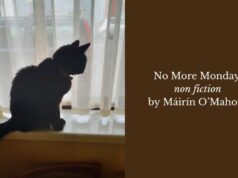
Spike Island: the Rebels, Residents and Crafty Criminals of Ireland’s Historic Island|John Crotty|Merrion Press|
A rattling good story told with verve, backed up by sound scholarship—Spike Island, by John Crotty
by John Kirkaldy
It is virtually impossible to write about Spike Island, the 103 acres island off Cork Harbour, without mentioning Alcatraz. It is easy to see why John Crotty does not even really try. He was for six years the island’s CEO, as it became a major tourist attraction after a long history, for which the term ‘chequered’ is totally inadequate.
The first three chapters of the book are a breathtaking jaunt through the Island’s history. It was first settled in the 7th century, when it is claimed that Saint Mochuda founded a monastery. Ownership changed over the centuries and it seems likely that in the 1650s, it was a Cromwellian holding depot for convicts bound for America and the West Indies.
The island became a major prison settlement in 1847, when it was opened to cope with social upheaval, mainly caused by the Famine
The island’s fate became increasingly dominated by British foreign policy and social problems. In 1779, the first artillery fortifications were built, due to war with the American colonies and hostility with France and Spain. It was the building of a 24 acre fortress in 1804 that was to underpin the Island’s subsequent development.
The Island became a major prison settlement in 1847, when it was opened to cope with social upheaval, mainly caused by the Famine. In the 1850s, it housed over 2,400 inmates, making it the largest prison in the world. In 1921, it became a Free State prison with up to 600 prisoners at any one time. In 1938, the Island was formally handed back to Ireland by Britain. (Taoiseach, Éamon de Valera delayed his visit until the Union Jack had been lowered and the last British soldier had left.) In 1985, it became a prison for young offenders but this was closed in 2004.
Visitors are now encouraged to view the fort, prison cells, punishment block, abandoned villages, convict cemeteries, gun emplacements and other key points of interest.

A historical backdrop, which contains nationalism, imperialism, crime and punishment, pirates and social distress, is hardly likely to be dull. Crotty has a good story to tell and he does it with verve, backed up by some sound scholarship. Larger than life characters jostle with bizarre situations, interspersed with the odd prison escape and the very occasional riot. The discovery of 1300 unmarked graves are another reminder of how tough life was for many prisoners. There is also enough space to fit in some day-to-day experiences of local inhabitants over the years.
Crotty has a good story to tell and he does it with verve, backed up by some sound scholarship
There are a few heroes in what is often a harrowing tale. Locally born, Elle Organ (also later known as Little Nellie), ended up dying of tuberculosis, aged four. She asked if she could have Holy Communion, just before she died. Her story later inspired Pope Pius X in 1910 to reduce the age of receiving the sacrament to seven years. Charles Vallancey, although very much an English establishment figure and one of the early designers of the Island’s infrastructure, was very sympathetic to Irish culture. Another member of that select local born group, known as the Spikeys, was the explorer, Percy Fawcett, who disappeared somewhere in South America in 1925.
Not surprisingly, Irish nationalists were a steady flow to the Island’s prison. An early enthusiast for the Irish flag, John Patrick Leonard, was jailed here. So too was Fenian, John Mitchel (his street cred was subsequently diminished somewhat by his active support for the pro-slavery Confederacy states in the American Civil War). As a result of the Irish Civil War, a TD, Seán Moylan, was held here for a while, as were nine members of the Cork City Council, alongside anti Treaty activists from all over Ireland.
There were numerous famous or infamous criminals among the prison population. Not all were from what Victorians would call the criminal classes. Joseph Dwyer took to murder when he could not keep up with a respectable middle-class pretence. William Kirwan was found guilty of the murder of his wife—but Irish society was rocked when it was discovered he also had a mistress with seven children. James Grey, a former soldier, designed his own travelling box, in which he could hide. When the coast was clear, he would emerge and help himself to what was on offer in the surroundings.
The book does not neglect the thousands of prisoners who passed through and were usually reduced to a statistic and a name in a ledger
‘The most famous criminal in twentieth-century Ireland, and arguably in Irish history,’ Dubliner Martin Cahill was in prison here. Nicknamed the General, he was seldom out of the news in the 1980s and 90s. After release, Brendan O’Donnell ‘would go on to commit the most heinous crime of 1990s Ireland, murdering a mother, her young child and a priest.’
The book does not neglect the thousands of prisoners who passed through and were usually reduced to a statistic and a name in a ledger. Crotty investigates the case of Edward Power, a convicted criminal in 1848, aged 14, whose crime was homelessness (at the time of the Famine). His life was subsequently a spiral downwards; convicted of murder and sentenced to hang in 1856. He did escape the gallows and was eventually released in 1881.
Another strength of the book is the use, where possible, of first-hand accounts of every day prison life. A clerical visitor in 1881, Cannon Sheehan described what he witnessed: ‘We saw but strong cages, tier over tier, walls and partitions of corrugated iron, and a string of wire or iron in front of each cage…Each cell was eight feet by four…and had its human occupant…Some were in bed, others sat drearily on the wretched wooden stool and stared like wild beasts at us…It was a human menagerie.’
Crotty investigates the case of Edward Power, a convicted criminal in 1848, aged 14, whose crime was homelessness (at the time of the Famine)
The island’s position and the surrounding sea made escape an impossibility, when under British command. A few tried but all were unsuccessful. Even the most daring, such as Henry Sweers, Dennis Hourigan and James Dwyer, failed in their attempts. Hourigan was an incorrigible would-be escaper with several other attempts in various gaols (he was first sentenced in 1859 for stealing three pigs). He was later imprisoned in Limerick, where he was kept naked in his cell to prevent any more attempts. Amazingly, he did manage to steal come clothes, escape and was never located!
Seven anti-Treaty prisoners did successfully escape in November 1921, when the gaol was run as a Free State prison. Shortly afterwards, all the remaining prisoners were returned to the main land, after a full-scale riot in October 1921.
Spike Island ended its time as a prison in spectacular and controversial fashion. In 1985, it was reopened to house young offenders. Cramped conditions, too few staff (and not enough of them fully trained), coupled with youthful bravado, led to a full-scale riot in August 1985, when buildings were burnt and property destroyed.
Spike Island ended its time as a prison in spectacular and controversial fashion
Prisoners on the roof were persuaded to come down, when one of the protesters was ordered to do so by his mother. An observer commented: ‘There was no negotiation or nothing, it was the Cork mammy. She was screaming, saying, “I’ll throw myself into moat” if he didn’t come down.’
The prison closed in 2004 and it became a tourist attraction in 2016. It was voted top European tourist attraction in 2017 by World Travels Award.
This is Crotty’s first book and he has delivered a rattling good read. It will be another reminder to visitors to the island, in whose footsteps they tread.

John Kirkaldy has a PhD in Irish History, worked for many years with the Open University and has been reviewing for Books Ireland since 1980. He has contributed to three Irish history anthologies, a school textbook, and has been involved in a number of Open University History documentary series. Aged 70, five years ago, he went round the world on a much delayed gap year described in his book, I’ve Got a Metal Knee: a 70-Year Old’s Gap Year.












